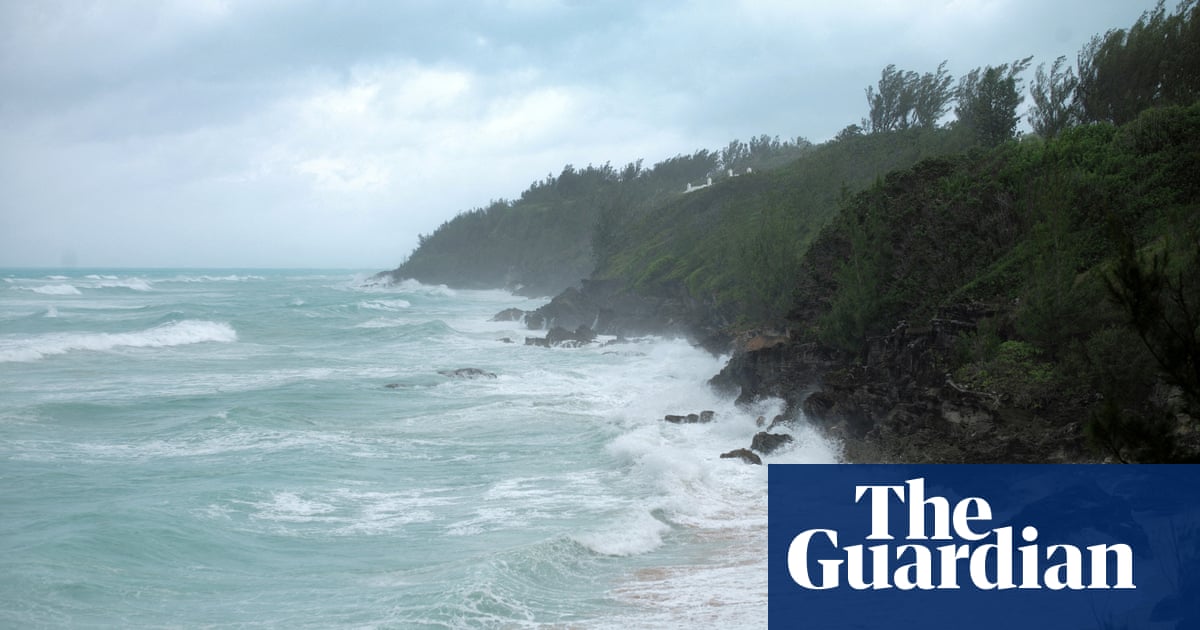
Hurricane Ernesto walloped Bermuda with winds reaching 85mph (137km/h) and waves exceeding 35ft (10.5 metres) offshore from the small British territory in the Atlantic Ocean, as it made landfall early on Saturday – with officials warning of potentially fatal flooding and storm surges.
The storm arrived as a category 1 hurricane after traveling over the archipelago overnight, a trajectory described as a “rare event” by the Weather Channel. It is uncommon for the eye of tropical cyclones to pass directly over these islands, per the network.
Fewer than 12 hurricanes have made landfall on this collection of 181 small islands since the 1850s, historic records indicate.
Bermuda, which has a population of about 64,000, was at risk of seeing 36 hours of hurricane and tropical storm-force winds from Friday onward, authorities advised. Before Ernesto even made landfall, gusts knocked out power for 5,400 of Bermuda’s 36,000 electricity customers.
Meteorologists predicted rains of up to 9in (23cm). Authorities have said that Ernesto is a large hurricane, with hurricane-force winds sprawling 75 miles from its center and tropical storm-force winds spanning up to 275 miles.
Warren Darrell, 52, of Smith’s parish, said he stockpiled groceries for his family, battened down the hatches and moved lawn furniture in advance of Ernesto’s arrival. While concerned, Darrell was not panicking.
“I’m ready to play games with my daughters and wait,” he reportedly said. “I’m a bit worried, a little bit worried, but I think we’ll overcome. I think we’ll be fine.”
In addition to Bermuda, the storm’s ocean swells affected portions of the Bahamas and the US east coast, the US National Hurricane Center said. A house in North Carolina collapsed into waves caused by Ernesto’s swells.
“A Rodanthe NC house was consumed by the ocean right in front of me!” read an Instagram caption beneath a video of the collapse.
New York City and National Park Service officials said that all beaches in the Brooklyn and Queens boroughs of the city would be closed for swimming on Saturday and Sunday. The National Weather Service forecast dangerous rip tides and swells reaching up to 6ft, the New York City mayor’s office said.
The National Hurricane Center said that Ernesto was moving north-east and could bring wind and rain to parts of the Canadian Newfoundland region on Monday.
Ernesto is the fifth named Atlantic storm of the hurricane season, and grazed Puerto Rico earlier this week as a tropical storm.
The National Oceanic and Atmospheric Administration (Noaa) has predicted that the 2024 hurricane season will be “extremely active” and potentially rank “among the busiest on record”. Meteorologists from Noaa’s Climate Prediction Center have forecasted there will be 17-24 named storms, meaning winds of 39mph or more, during this season, which spans from 1 June until 30 November.
They expect that eight to 13 of these named storms could become hurricanes, with winds of 74mph or more. Of these hurricanes, they predict that four to seven could be deemed major, meaning they have winds of 111mph or more.
A typical Atlantic hurricane season sees 14 named storms, half of which become hurricanes and three of which become major hurricanes. Officials said the Atlantic basin is poised to be “remarkably active” due to warmer-than-average surface temperatures in the Atlantic Ocean’s tropical region, as well as weaker trade winds, and an intensified west African monsoon.
The climate crisis is largely the culprit for rising ocean temperatures. When fossil fuels are burned, they release “heat-trapping” materials into the atmosphere, and oceans absorb the majority of this excess heat.
La Niña, the oceanic cycle, could also develop over the next few months.
Because of these atmospheric and oceanic conditions, forecasters believe that there is a mere 10% chance that this hurricane season will be normal. Noaa noted that Hurricane Beryl, which made landfall in Texas early last month, was the earliest category 5 Atlantic hurricane on record.
Beryl, a “supercharged” storm, caused some 20 deaths in several Caribbean islands, and some 25 fatalities in Texas, Louisiana and Vermont, according to Noaa. Hurricane Debby hit Florida’s Gulf coast just over a week ago.
Reuters and the Associated Press contributed reporting
Source: theguardian.com

















